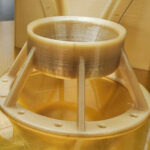The continued expansion of 3D printing into industrial sectors is thanks not only to larger and faster 3D printers but also tougher materials. One of those materials is PEEK. PEEK is incredibly strong and high temperature resistant and has a cousin called ULTEM or Polyetherimide (PEI). ULTEM shares many of the same favorable characteristics. Due to its adhesive properties and chemical stability, 3D printing enthusiasts may better recognize ULTEM by its chemical name of polyetherimide, or PEI, as that’s how it’s named as a bed material used on some FFF/FDM printers.
ULTEM Introduction
ULTEM was developed in the 1980s by Joseph Wirth at General Electric’s Plastics Division, which was acquired in 2007 by SABIC. Compared to PEEK, ULTEM has a lower impact strength and useable temperature, but it’s also significantly cheaper. And just because it isn’t quite as strong as PEEK does not mean it’s a slouch. ULTEM’s tensile strength is 15,200 psi and it has a flexural modulus of 480,000 psi. It has very high heat resistance, maintaining most of its physical properties in temperatures as high as 170°C. Additionally, it has a high dielectric strength and can go through thousands of cycles in a steam-based sterilization autoclave without degradation. Its strength-to-weight ratio is also quite similar to that of aluminum and it can be machined with conventional metalworking tools.
Those mechanical and thermal properties are ideal for a number of demanding applications, from aerospace to medical to electrical. Indeed, ULTEM holds several aerospace certifications and is FDA compliant. In planes and rockets, ULTEM is used in ventilation systems, latches and hinges, and cable ducts. Medical professionals and research scientists often use instruments made from the material, and electrical component manufacturers use ULTEM in connectors, insulation parts, and chip test sockets.
ULTEM / PEI Material Types
Because of its very high glass transition temperature of 217°C (for comparison, PLA has a glass transition temperature of 60°C), working with the material requires more specialized hardware than what’s found in most 3D printers. The extruder has to reach at least 350°C and the bed must reach 150°C; an enclosed and heated build chamber is also necessary to maintain dimensional accuracy.
There are two ULTEM material types, the ULTEM 1010 (resin material) and the ULTEM 9085 (filament material). Both material types come with different applications and different print settings. SABIC recently introduced a new series of more new high performance PEI materials that are based on the ULTEM 1010.
ULTEM 1010
Properties
- High tensile strength. This material has the highest tensile strength of all FDM filaments. This results in strong and durable parts.
- High thermal stability. With its excellent thermal stability and heat resistance this material can also withstand autoclaving (steam sterilisation for medical parts).
- NSF 51 food-contact certification, the only FDM material that has this certification.
- Biocompatible (ISO 10993/USP Class VI certifications).
Applications
Due to its food-contact and bio-compatibility certifications, ULTEM 1010 is a very suitable option for applications within the food industry and medical industry. You can think of production tools that come in contact with food and medical devices like surgical guides, fixtures and custom apparatus.
Other industries where ULTEM 1010 is used are the aerospace and automotive industries. Due to its high strength and thermal stability, this material can be used in semi-structural components and out-of-cabin aerospace applications.
Recommended printer settings
- Extruder Temperature (all metal extruder necessary): 370 – 390°C
- Print Bed Temperature: 120 – 160°C
- Print bed adhesion: Perf board, Kapton tape or Lightly sanded FR4
- Heated Enclosure: YES, this is required, the printing of ULTEM performs best in a hot build environment
- Printing speed: 20-30 mm/s
ULTEM 9085
Properties
- Very high strength-to-weight ratio. ULTEM 9085 offers comparable impact strength to metal parts like aluminium but can be made much lighter.
- High thermal resistance. ULTEM 9085 has a heat deflection temperature of 167°C.
- Inherently flame retardant. FST-compliant and certified for aircraft components.
- Chemical resistance. Resistant to a wide range of chemicals (e.g. alcohols, automotive fluids & aqueous solutions).
Applications
The properties of ULTEM 9085 make it an ideal for aerospace and automotive applications, providing high-performance parts and a lightweight alternative to metal. The most important property of ULTEM 9085 must be the high strength-to-weight ratio. Because this is extraordinary high for a plastic based material, its applications can be found in the aerospace and automotive industries. Applications of ULTEM 9085 are found in places where the weight of an object significantly has an effect on the cost of operation but object-strength is of the utmost importance. Examples of this can be found in aircrafts where weight of the aircraft directly correlates to the amount of fuel consumed.
Besides these industrial applications, ULTEM 9085 can also be used to 3D print interior components, ductwork or electrical enclosures.
Recommended printer settings
- Extruder Temperature (all metal extruder necessary): 350 – 390°C
- Print Bed Temperature: 130 – 160°C
- Print bed adhesion: Perf board, Kapton tape or Lightly sanded FR4
- Heated Enclosure: YES, this is required, the printing of ULTEM performs best in a hot build environment
- Printing speed: 20-30 mm/s


